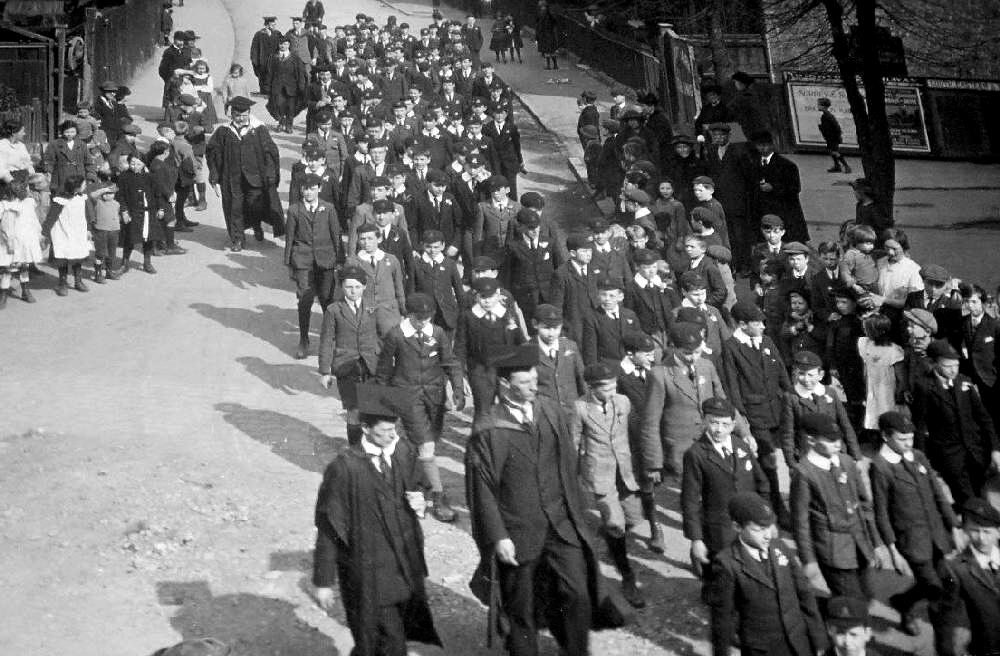
Individual English Schools -- Whitgift School

Figure 3.--This was Whitgift Grammar School Founder's Day in 1920. It honors the laying of when the foundation stone of what came to be called the Whitgift Alms House. The boys and masters here parade through Croydon headed by the OTC Band a followed by the boys of the Whitgift Grammar and Middle Schools. They laid wreaths at the War Memorials and thn marched to the Church. Also at the Church aging brethern and sister of the almshouses. After the blessing and service, the Congregation filed by Whitgift's tomb.
|
|
Whitgift School is today a private day school with a small boarding unit in South Croydon south of London. In addition to Trinity School of John Whitgift and Old Palace School it is owned and operatd by the Whitgift Foundation, a charitable trust. It is associated with the Church of England. It is one od several schools dating back to Tudor times. The school was founded by the Archbishop of Canterbury John Whitgift during the final years of Queen Elizabeth's reign (1596). This was when the foundation stomeof what came to be called the Whitgift Alms House was laid. It opened 4 years later (1600). It was funded by the Whitgift estate and subsequent Foundation. Whitgift sought to create a hospital and school in Croydon for the "poor, needy and impotent people" from the parishes of Croydon and Lambeth. It is today Croydon's oldest school. It is a private school, but not a public school because it began as a charity institution. The school was originally situated in North End, Croydon. Here we see a scene during Founder's Day (1920). Notice the unform, a school cap and suit. Many boys wore Eton collars, but they ere not required (figure 1). We notice another group in the school parade, perhaps a younger form (year grade), with more boys wearing Eton collars. Before World War I (1914-18) virtually all the boys would have worn Eton collars. There was no uniform jacket style, but knicker suits were the uniform requirement. Older boys wore long pants. One boy wears knee socks. At the time short pants and knee socks had begun to replace knee pants, knickers, and long stockings. Most boys in he ealy 20th century wore knee pants, but in the private schools and grammar schools, knickers were more common. We also see this process in Middle School boys associated with Whitgift. . The school was moved to its current site, Haling Park (1931). After World War I, aristocratic families found it increasingly difficult to keep up palatial esates. Many had to be sold and several were turned into schools. Haling Park was the home of Lord Howard of Effingham--the Lord High Admiral of the Fleet who sailed against the Spanish Armada. The school becane a direct Grant Grammar School (1871). It was called Whitgift Grammar School. The School relinquished its direct grant and became a fully private school -- Whitgift School (1946).
HBC -- SU

Related Chronolgy Pages in the Boys' Historical Web Site
[The 1880s]
[The 1930s]
[The 1940s]
[The 1950s]
[The 1960s]
[The 1970s]
[The 1980s]
Related Style Pages in the Boys' Historical Web Site
[Long pants suits]
[Short pants suits]
[Socks]
[Eton suits]
[Jacket and trousers]
[Blazer]
[School sandals]
Navigate the Boys' Historical Clothing School Uniform Pages
[Return to the Main English M-Z individual school page]
[Return to the Main English individual school page]
[Australia]
[England]
[France]
[Germany]
[Ireland]
[Italy]
[Japan]
[New Zealand]
[Scotland]
[United States]
Navigate the HBC School Section:
[About Us]
[Activities]
[Chronology]
[Clothing styles]
[Countries]
[Debate]
[Economics]
[Garment]
[Gender]
[Hair]
[History]
[Home trends]
[Literary characters]
[School types]
[Significance]
[Transport and travel
[Uniform regulations]
[Year level]
[Other topics]
[Images]
[Links]
[Registration]
[Tools]
[Return to the Historic Boys' School Home]
Created: 7:22 AM 9/9/2017
Last updated: 7:22 AM 9/9/2017




